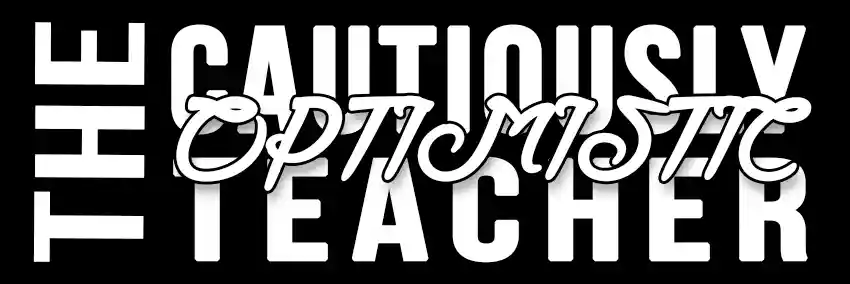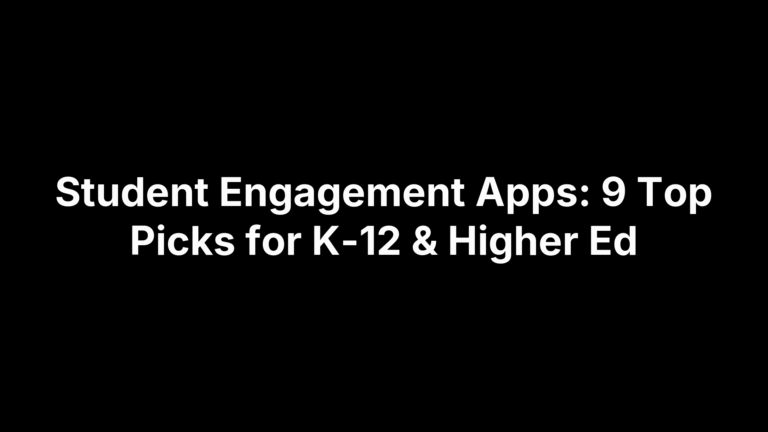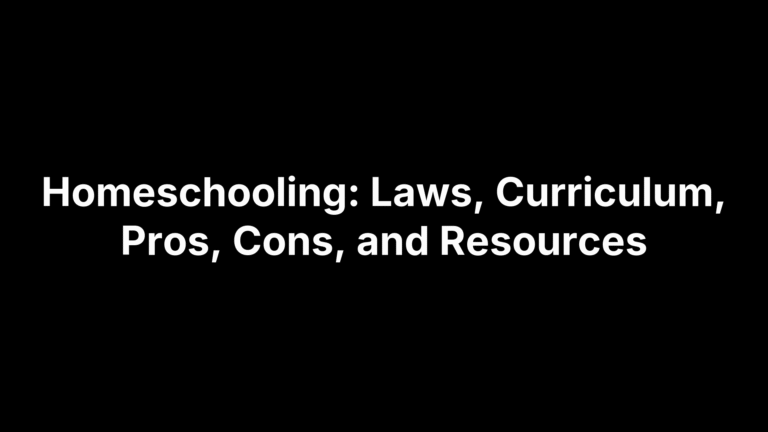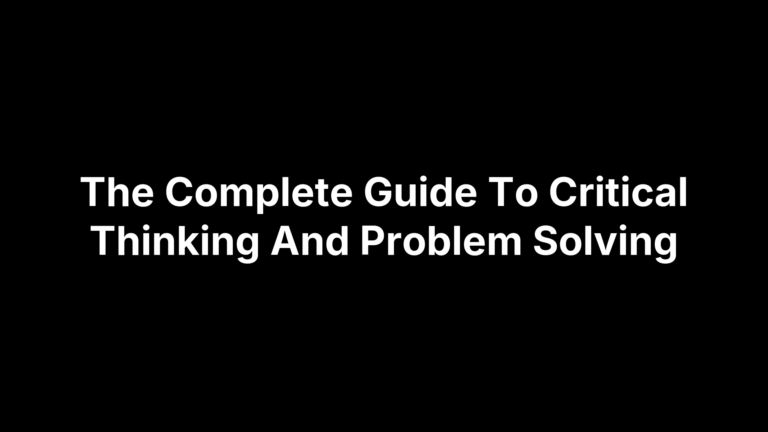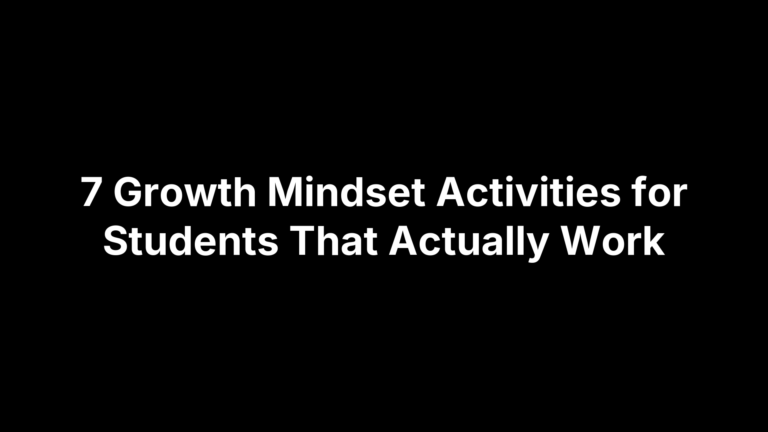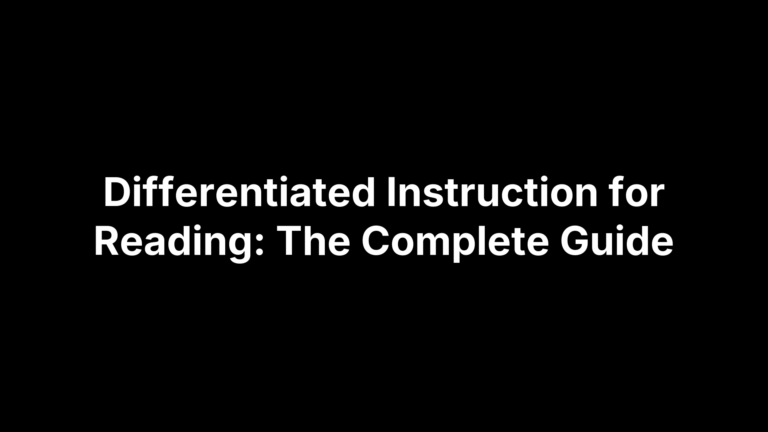14 Proven Ways: How to Motivate Students in Any Classroom
What turns a yawning student into one who leans forward, asks questions, and keeps working long after the bell? Relevance, ownership, and positive emotion. When a lesson feels immediately useful, offers choice, and produces small hits of success, motivation climbs—no matter the grade level or subject. The 14 research-backed strategies below show exactly how to build that dynamic in any classroom, whether you’re guiding kindergartners through phonics or AP seniors through calculus. They require no pricey programs, only intentional tweaks to planning, relationships, and feedback loops. Better yet, most can be rolled out tomorrow.
Motivation is a blend of intrinsic sparks—curiosity, pride, purpose—and extrinsic nudges like grades or praise. Effective teachers don’t pick one; they choreograph both. You’ll see how to set crystal-clear goals, weave meaningful choice into lessons, use game mechanics without turning learning into a gimmick, and leverage AI tools that cut prep time so you can focus on students. Each tactic comes with concrete examples and low-prep resources you can copy or modify. Scroll on, pick a starting point, and watch engagement rise. Bonus links to free printable templates and interactive activities are sprinkled throughout to make implementation painless for busy educators.
1. Provide Ready-Made, High-Interest Resources and AI Tools (The Cautiously Optimistic Teacher)
Nothing turbo-charges motivation like lessons that feel fresh and tailored without adding hours to your prep. The free and premium tools at The Cautiously Optimistic Teacher hand teachers grab-and-go materials in minutes—worksheets, Socratic questions, growth-mindset mini-lessons, even full essay units. By outsourcing the repetitive design work, you gain time to circulate, confer, and celebrate wins—exactly the human touches research links to higher engagement.
Why It Works
- Planning time shifts to relationship-building and feedback—two of the strongest drivers of student effort.
- AI-differentiated tasks hit multiple reading levels and learning preferences, keeping every learner in the productive struggle zone.
How to Implement
- Use the Worksheet Maker for bell-ringers or exit tickets that align with today’s objective.
- Drop a prompt into the Question Generator to create higher-order discussion starters for Socratic seminars.
- Embed a Brain Builders Workshop activity each Monday to teach students explicit motivation and study skills.
Classroom Example
In 8th-grade ELA, students warmed up with a “Rhyme Time Challenge,” drafted opinion essays via the Essay Writing Tools unit, and saw on-time submission rates climb from 68 % to 91 % in one quarter.
2. Set Clear, Achievable Goals and Show the Roadmap
Students can’t hit a target they can’t see. Transparent, bite-sized objectives turn an abstract semester grade into daily wins they can chase. When learners understand exactly what “good” looks like—and how today’s activity moves them closer—effort rises without the teacher nagging. It’s a simple but underrated lever if you’re wondering how to motivate students quickly.
Why It Works
- Concrete goals raise expectancy; students believe success is within reach.
- Visible checkpoints reduce anxiety by clarifying “What’s next?”
- Celebrating incremental progress releases dopamine, fueling further engagement.
Steps to Take
- Co-create
SMART(Specific + Measurable + Achievable + Relevant + Time-bound) goals at unit, weekly, and daily levels. - Post learning targets and exemplar work where everyone can see them.
- Preview the “path” at the start of each lesson: objective → activity → evidence of mastery.
Progress-Tracking Ideas
- Personal goal sheets students color in after each milestone.
- A digital tracker (Google Sheets + conditional formatting) that auto-updates class averages.
- Data wall with movable name magnets so growth is public yet non-competitive.
- End-of-week reflection slips asking, “Which step did I master? What’s my next dot on the roadmap?”
3. Offer Meaningful Choice and Voice (Student Autonomy)
When learners help shape their work, they invest in it. Micro-choices—topic, tool, or turn order—signal trust, flip ownership, and crank up persistence and creativity more reliably than any sticker chart. Students start saying “my project,” not “the assignment.”
Why It Works
- Autonomy sits at the core of Self-Determination Theory motivation.
- Choice lifts perceived control, driving effort and deeper processing.
- Voice meets social needs and makes learning feel personally relevant.
Choice Points to Embed
- Topic or text from a curated menu.
- Product format: slide deck, podcast, comic, demo.
- Pathways: stations, playlists, or mastery checklists.
Voice Amplifiers
- Student-led discussions or mini-lessons.
- Quick surveys to co-write rubrics.
- Class norms negotiated and revisited quarterly.
4. Gamify Learning with Intrinsic Rewards, Not Just Points
Turn routine practice into an adventure and watch even reluctant learners lean in. By layering game mechanics—progress bars, narrative challenges, secret “easter eggs”—on top of academic tasks, you create the quick feedback loops and sense of progression students naturally crave. The trick is to make the “win state” about mastery, collaboration, or real-world impact, not a sugar rush of tokens that lose meaning after week two. Done right, gamification becomes a stealth answer to how to motivate students without piling on extra grading.
Why It Works
- Game structures trigger dopamine releases tied to curiosity and accomplishment.
- Clear levels and immediate feedback clarify what to do next, reducing cognitive load.
- Shared quests foster community and healthy peer accountability.
Practical Gamification Elements
- Levels or “skill trees” that unlock tougher challenges
- Digital or paper badges for demonstrated competencies
- Narrative quests (“Save the wetlands!”) spanning a unit
- Instant feedback via progress bars or auto-graded mini-boss quizzes
Keep It Authentic
- Link every badge to a rubric criterion or standard.
- Celebrate side quests that showcase grit or mentorship.
- Retire point systems once habits stick—let intrinsic pride take the wheel.
5. Build a Strong Teacher–Student Relationship and Supportive Community
Classrooms where every learner feels known, safe, and valued naturally generate higher effort. When students sense that the teacher is rooting for them—and that peers are allies, not judges—they take academic risks, ask for help, and stay the course on tough tasks. If you’re wondering how to motivate students who seem checked out, start with connection before content.
Why It Works
- Belonging satisfies a core psychological need, unlocking intrinsic drive.
- Warm relationships elevate oxytocin levels, reducing stress and freeing cognitive bandwidth for learning.
- Community norms create positive peer pressure; students work harder to help the group succeed.
Daily Routines
- Two-minute conferences: brief eye-level chats about non-academic interests.
- Door greetings with name + handshake, fist-bump, or ASL sign.
- “Rose & thorn” exit slips to share daily highs and lows and spot silent struggles.
Inclusive Community Builders
- Co-authored class agreements displayed and revisited monthly.
- Peer praise wall where students pin sticky notes recognizing effort and kindness.
- Rotating roles (tech captain, empathy checker, question collector) that give every learner visible responsibility.
6. Connect Lessons to Real-World Relevance and Future Goals
When students can visualize exactly where a skill shows up—cashing a paycheck, editing a TikTok, fixing a tire—the grind feels purposeful. If you’re wrestling with how to motivate students, linking content to goals they actually care about works wonders.
Why It Works
- Utility value answers the perennial “When will I ever use this?” and lowers resistance
- Future selves become vivid, boosting persistence through boring or difficult steps
- Relevance signals respect for students’ lives outside school, strengthening relationships
Strategies to Try
- Guest speakers—plumbers to programmers—linked to current unit objectives
- Design PBL around local issues like traffic flow or food deserts
- Service learning: math class crafts budget proposals for a charity drive
Example
In Algebra I, students mapped bus routes for a proposed community garden, calculated mileage costs, and pitched their plan to city council. Attendance spiked during the week-long project and 92 % mastered linear-function targets.
7. Scaffold Tasks and Celebrate Small Wins to Build Confidence
Nothing crushes engagement like assignments that feel impossible. Break learning into climbable hills—and cheer each summit—and watch confidence bloom. Strategic scaffolding paired with quick recognition is one of the most efficient answers to how to motivate students who fear failure. Over time, the competence-feedback loop replaces “I can’t” with “What’s next?”
Why It Works
- Right-sized challenges keep students in the productive struggle zone, avoiding frustration or boredom.
- Visible growth moments release dopamine, reinforcing effort.
- Public and private praise normalize mistake-making as part of mastery.
Scaffolding Techniques
- Chunk multi-step tasks into color-coded checklists.
- Model first with a think-aloud, then provide worked examples.
- Offer sentence starters or graphic organizers before independent writing.
- Use peer “elbow experts” for immediate, non-teacher help.
Micro-Celebrations
- “Nailed it” stickers or digital badges for each sub-goal.
- Quick shout-outs during a two-minute wrap-up circle.
- Progress graphs students update with a single emoji.
8. Teach Growth Mindset and Metacognitive Reflection
Students push harder when they believe effort rewires the brain and when they know how to monitor that effort in real time. Embedding short mindset lessons and giving learners simple reflection rituals shifts the internal narrative from “I’m bad at this” to “I haven’t mastered it yet.” That mental reframe fuels persistence long after external rewards fade.
Growth Mindset Mini-Lessons
- Show a two-minute neuroplasticity clip, then have students annotate where practice builds new synapses.
- Replace “smart” and “talented” praise with verbs—“You analyzed multiple strategies.”
- Share famous “failure resumes” (Abe Lincoln’s election losses, J.K. Rowling’s rejections) and discuss turning points.
- Post sentence stems: “My mistake taught me …,” “Next time I will ….”
Reflection Tools
- Color-coded “traffic light” cards: green = got it, yellow = need help, red = re-teach.
- One-minute Flip video reflections that answer, “What strategy worked for me today?”
- Weekly learning journals with a prompt to graph effort vs. outcome.
- Digital exit slips auto-emailed back to students, creating a personal feedback archive.
9. Give Timely, Specific, Actionable Feedback
Nothing tanks motivation faster than waiting a week to hear “good job” or “fix this.” Students need to know what they did well or poorly and how to improve while the work is still fresh in their minds. Quick, laser-focused feedback turns confusion into a clear next step—fueling momentum rather than frustration.
Why It Works
- Immediate cues keep neural pathways active, helping corrections stick.
- Focused comments narrow attention to one or two upgrade points, preventing overload.
- Action verbs—revise, combine, elaborate—prime students for the very next move, not a vague future.
High-Impact Feedback Methods
- “Glow/Grow” sticky notes: one strength, one target.
- Five-minute desk conferences during independent work time.
- Audio notes embedded in Google Docs for tone and detail.
- Rubric snapshots: highlight the current column, circle the next-level criterion.
Leveraging Technology
- AI comment generators for drafts, freeing you to coach higher-order thinking.
- Screencast walk-throughs that pair spoken guidance with on-screen mark-ups.
- Auto-graded quizzes that release hints after each attempt, turning assessment into practice.
10. Optimize the Physical and Digital Learning Environment
A cluttered room or a maze-like LMS can sap energy before learning even starts. Streamlining both spaces removes friction so attention can flow to the task—an often-overlooked lever when figuring out how to motivate students.
Why It Works
- Clear, calm visuals lower cognitive load and anxiety.
- Easy access to materials shortens transition time, extending true learning minutes.
- Consistent layouts create safety; brains aren’t busy decoding the environment.
Environmental Tweaks
- Unblock walkways and label supply zones with icons.
- Offer two or three flexible seating options, max.
- Use muted wall colors plus a single high-contrast focus board.
- Post visual timers to set pace.
Digital Parallel
- Keep LMS navigation to three clicks or fewer.
- Use uniform icons and color codes for each unit.
- Embed resources directly—no PDF scavenger hunts—to maintain momentum.
11. Promote Collaboration and Peer Teaching
Nothing boosts energy like learning from, and with, classmates. Structured teamwork lets students explain ideas aloud, spot misconceptions in real time, and feel accountable to someone other than the teacher—an under-used lever when planning how to motivate students.
Why It Works
- Social interaction satisfies the relatedness drive in Self-Determination Theory.
- Teaching a concept forces students to reorganize knowledge, deepening mastery (the “protégé effect”).
- Shared goals distribute risk; kids attempt harder tasks when failure is collective, not personal.
Collaboration Structures
- Jigsaw: each group masters one slice, then re-teaches it.
- Think-Pair-Share: quick, low-prep verbal rehearsal.
- Peer tutoring rotations: high-flyers coach, then switch roles.
- Fishbowl debate: inner circle discusses, outer observes for evidence use.
Norms for Success
- Post a co-created rubric covering listening, equal talk time, and respectful challenge.
- Assign rotating roles—facilitator, checker, reporter—to balance participation.
- Close with a 60-second group reflection: “What worked? What will we tweak?”
12. Incorporate Movement and Brain Breaks
Bodies that sit too long put brains to sleep. Even a sixty-second stretch floods the prefrontal cortex with oxygen, resets attention, and melts away low-level stress. Build brief, predictable movement pauses into lessons and watch lethargy turn into laser focus.
Why It Works
- Physical activity boosts oxygen and glucose delivery to the brain.
- Novel motions trigger dopamine, reigniting curiosity.
- Shared movement moments foster classroom camaraderie.
Quick Brain Break Ideas
- 60-second stretch with silent countdown.
- Vocabulary charades using today’s key terms.
- Stand-up/sit-down instant polls to preview content.
Structured Movement
- Gallery walk: students annotate posters around the room.
- Learning stations that require physical rotation every 10 minutes.
- Kinesthetic modeling—e.g., forming human molecules in science.
13. Spark Curiosity Through Storytelling and Mystery
Ever notice how a hush falls when you start a lesson with “Let me tell you a story …”? Narrative suspense taps the brain’s reward center; students keep listening to close the information gap. By wrapping standards-based content in cliff-hangers, cold cases, and puzzling images, you create an itch that only learning can scratch—an elegant answer to how to motivate students without extra prizes or points.
Why It Works
- Stories light up multiple brain regions (sensory, motor, emotional), making new information stick.
- A “knowledge gap” triggers dopamine release, sustaining attention until the mystery resolves.
- Shared intrigue builds collective energy and primes rich discussion.
Narrative Hooks
- Start history with a “you-are-there” diary entry from an unknown figure.
- Open science class with a real headline about a baffling phenomenon.
- Use character backstories in math word problems to humanize variables.
Mystery Techniques
- Drip clues each day; let students revise hypotheses on a whiteboard timeline.
- Run a “Notice/Wonder” protocol around an ambiguous image or data set.
- Hide QR-code Easter eggs around the room that unlock new evidence when scanned.
14. Recognize Effort, Progress, and Mastery Publicly and Privately
Want a low-prep lever for how to motivate students instantly? Catch them doing something right. Research shows that targeted recognition—calling out the exact strategy, risk, or improvement—multiplies the chance they’ll repeat it. Whether the spotlight is a class cheer or a quiet sticky note on a desk, acknowledgement turns invisible grind into visible momentum.
Why It Works
- Celebrations signal that growth—not perfection—counts.
- Specific praise highlights tactics to replicate.
- Public or private kudos release dopamine, locking habits in place.
Recognition Systems
- Digital badge board that lights up when a standard is mastered.
- “Shout-out of the Day” where peers nominate classmates for perseverance.
- Quick parent email celebrating a new personal best.
- Mystery Motivator: unannounced reward when the whole class hits a collective goal.
Balance and Equity
Rotate criteria—creativity today, teamwork tomorrow—to ensure every learner’s strengths surface, not just the usual honor-roll names. Equity in praise builds trust and sustains motivation for all.
Putting It All Together
Motivation isn’t a single switch you flip; it’s an ecosystem you grow. When clear goals show the path, choice and gamified challenges make the walk engaging, and strong relationships offer safety nets, students find reasons to push past discomfort. Layer in timely feedback, scaffolds that guarantee early wins, and a room—physical or virtual—that feels easy to navigate, and you’ve hit the sweet spot where curiosity, competence, and community reinforce one another.
Think of the 14 strategies as modular building blocks. Mix and match them to fit your style, grade level, and bandwidth:
- Autonomy: choice boards, voice in norms
- Relevance: real-world projects, guest experts
- Community: daily check-ins, peer praise walls
- Momentum: micro-celebrations, swift feedback loops
Start small—perhaps a 60-second brain break plus a SMART goal tracker—and observe the ripple effect. As routines solidify, add another layer until the culture almost runs itself.
Ready for templates, AI tools, and more classroom-tested ideas? Cruise over to The Cautiously Optimistic Teacher and grab what you need to keep the motivational fire burning long after the novelty fades.
